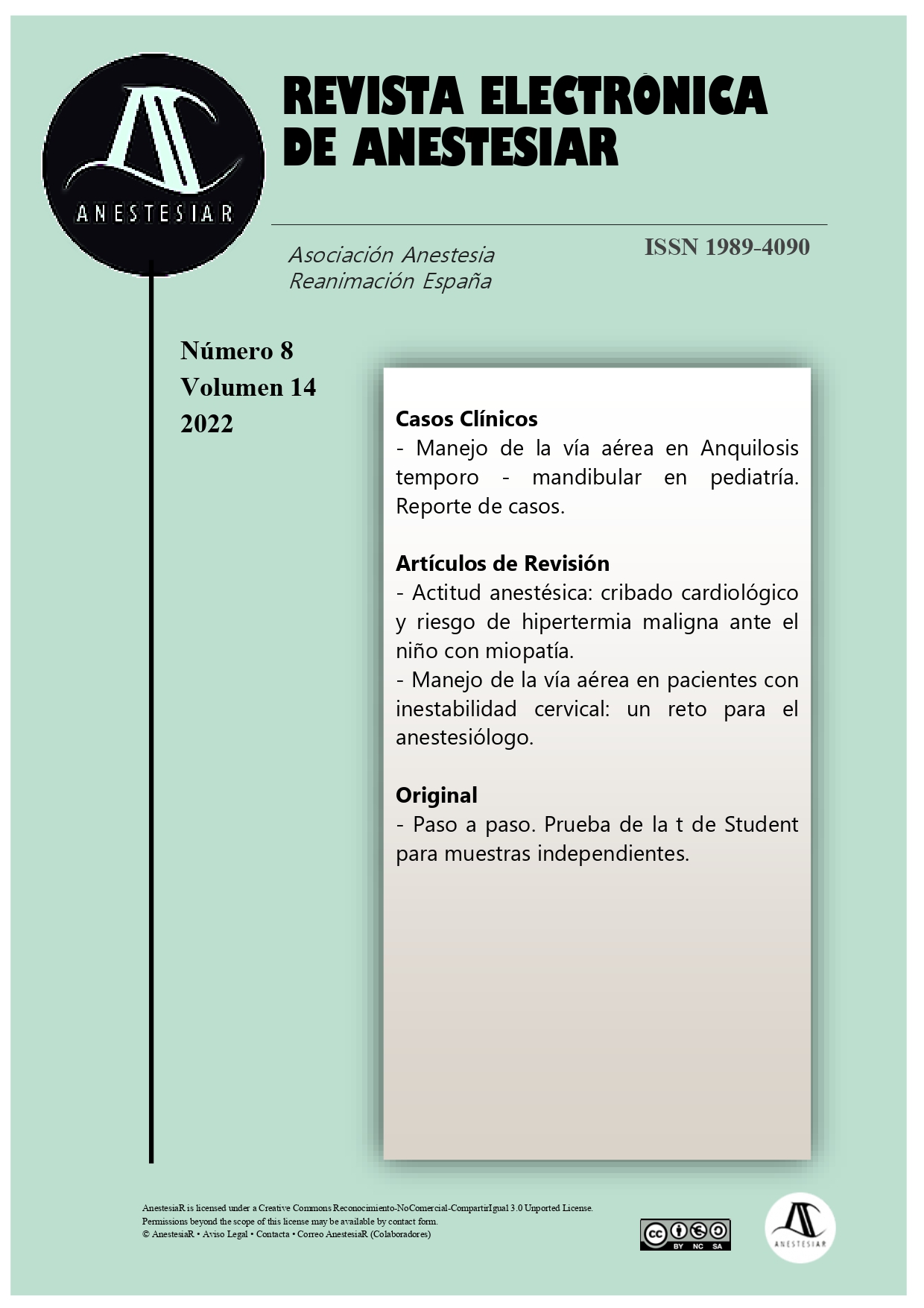Airway management in patients with cervical instability: a challenge for the anesthesiologist
DOI:
https://doi.org/10.30445/rear.v14i8.1127Keywords:
Cervical instability, spinal injury, cervical trauma, cervical immobilization, manual online stabilization, difficult airwayAbstract
Cervical spine injury occurs in 3-4% of trauma patients, out of which 25% have a cervical spinal cord injury. Airway management has inherent risks in patients with cervical injury, whether the instability is previously known or not, since even the simplest maneuvers can displace the injured cervical spine. The action guidelines recommend manual stabilization in line together with laryngoscopy to minimize cervical displacement, as well as the use of transglottic devices to resolve worsening of the Cormack-Lehane grade. However, given the limited evidence of the efficacy of the MILS maneuver in minimizing cervical spinal movement and its association with side effects, together with the high prevalence of patients with difficult airways and the great technological development that has occurred in recent years, has led to the approach of new alternatives for airway management in these situations. Therefore, immobilization of the cervical spine through manual in-line stabilization is increasingly controversial and optical devices are increasingly used.
References
- D’Arville A, Walker M, Lacey J, Lancman Benn, Hendel S. Airway management in the adult patient with an unstable cervical spine. Curr Opin Anesthesiol. 2021; 34:597-602. doi: 10.1097/ACO.0000000000001040.
- San Juan Rodríguez M, Carbonell Soto M.M, De la Flor Robledo M, Rodríguez Bertos C. Manejo de la Vía Aérea Difícil en Inestabilidad Cervical. Manual de manejo de la vía aérea difícil. 3º ed. Madrid: AnestesiaR. 2017: 317-328.
-Wiles MD. Manual in-line stabilisation during tracheal intubation: effective protection or harmful dogma? Anaesthesia. 2021, 76, 850–853. doi: 10.1111/anae.15472.
- Hindman BJ, Palecek JP, Posner KL, et al. Cervical spinal cord, root, and bony spine injuries: a closed claims analysis. Anesthesiology. 2011; 114:782–795. doi: 10.1097/ALN.0b013e3182104859.
- Kwan I, Bunn F, Roberts IG. Spinal immobilisation for trauma patients. Cochrane Database Syst Rev. 2001; 2001(2):CD002803. doi: 10.1002/14651858.CD002803.
- Velopulos CG, Shihab HM, Lottenberg L, et al. Prehospital spine immobilization/ spinal motion restriction in penetrating trauma: a practice management guideline from the Eastern Association for the Surgery of Trauma (EAST). J Trauma Acute Care Surg. 2018; 84(5):736–744. doi: 10.1097/TA.0000000000001764.
- Asha S, Curtis K, Healy G. Neurologic outcomes following the introduction of a policy forusing soft cervical collars in suspected traumatic cervical spine injury: a retrospective chart review. Emerg Med Australas. 2021; 33:19–24. doi: 10.1111/1742-6723.13646. Epub 2020 Oct 9.
- Nolan JP, Wilson ME. Orotracheal intubation in patients with potential cervical spine injuries. An indication for the gum elasti cbougie. Anaesthesia. 1993; 48(7): 630–3. doi: 10.1111/j.1365-2044.1993.tb07133.x.
- Hindman BJ, From RP, Fontes RB, et al. Laryngoscope force and cervical spine motion during intubation in cadavers-cadavers versus patients, the effect of repeated intubations, and the effect of type II odontoid fracture on C1–C2 motion. Anesthesiology. 2015; 123 (5): 1042–58. doi: 10.1097/ALN.0000000000000830.
- Singleton BN, Morris FK, Yet B, et al. Effectiveness of intubation devices in patients with cervical spine immobilisation: a systematic review and network meta-analysis. Br J Anaesth. 2021; 126(5):1055–1066. doi: 10.1016/j.bja.2020.12.041
- Romito JW, Riccio CA, Bagley CA, et al. Cervical spine movement in a cadaveric model of severe spinal instability: a study comparing tracheal intubation with 4 different laryngoscopes. J Neurosurg Anesthesiol. 2020; 32(1):57–62. doi: 10.1097/ANA.0000000000000560.
- Paik H, Park H-P. Randomized crossover trial comparing cervical spine motion during tracheal intubation with a Macintosh laryngoscope versus a C-MAC Dblade videolaryngoscope in a simulated immobilized cervical spine. BMC Anesthesiology. 2020; 20:201.
- Epaud A, Levesque E, Clariot S. Dramatic cervical spine injury secondary to videolaryngoscopy in a patient suffering from ankylosing spondylitis. Anesthesiology. 2021; 135(3):495-496. doi: 10.1097/ALN.0000000000003866.
- Brimacombe J, Keller C, Künzel KH, Gaber O, Boehler M, Pühringer F. Cervical spine motion during airway management: a cine fluoroscopicstudy of the posteriorly destabilized third cervical vertebrae in human cadavers. AnesthAnalg 2000. 91 (5): 1274-8.
- Alonso Ramos I, Pretus Rubio S, San Juan Rodriguez E. Técnicas multimodales de manejo de la vía aérea difícil. En: Master en Vía Aérea y Ventilación mecánica. Sección III: Abordaje avanzado de la vía aérea. Panamericana. 2022. Pendiente de publicación en 2022.
- Lenhardt R, Burkhart MT, Brock GN, Kanchi-Kandadai S, Sharma R, Akça O. Is video laryngoscope-assisted flexible tracheoscope intubation feasible for patients with predicted difficult airway? A prospective, randomized clinical trial. Anesth Analg. 2014; 118:1259–65. doi: 10.1213/ANE.0000000000000220.
Downloads
Published
How to Cite
Issue
Section
License
Copyright (c) 2022 Revista Electrónica AnestesiaR

This work is licensed under a Creative Commons Attribution-ShareAlike 4.0 International License.
 Envío y derechos de autor
Envío y derechos de autor


 Revista Electrónica AnestesiaR by
Revista Electrónica AnestesiaR by 